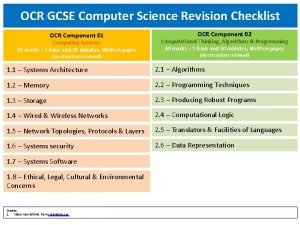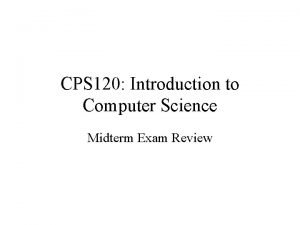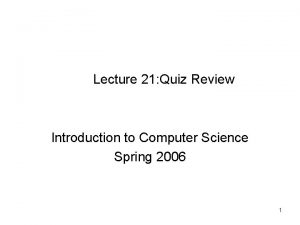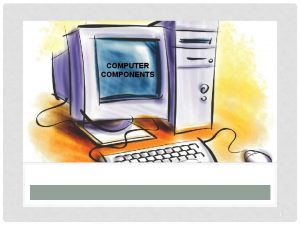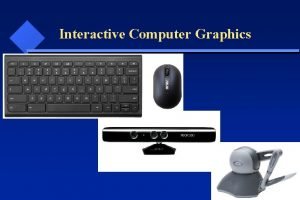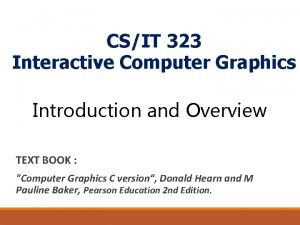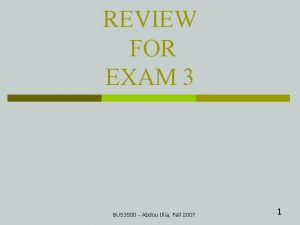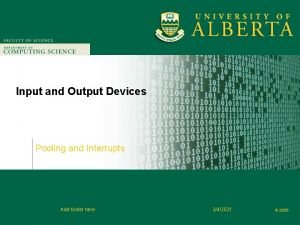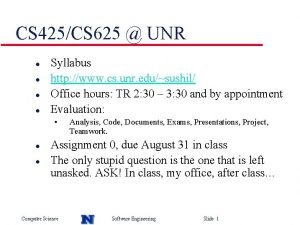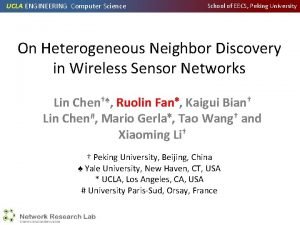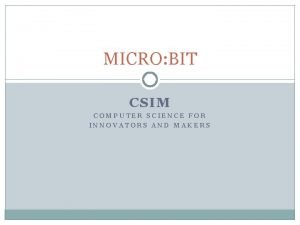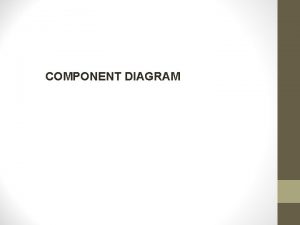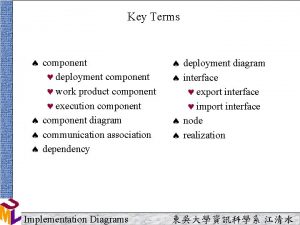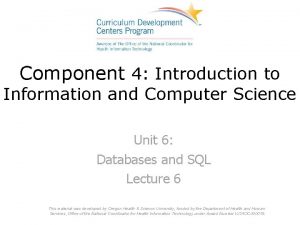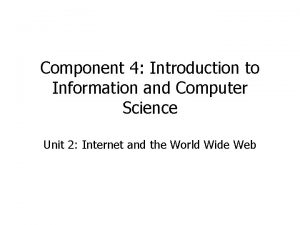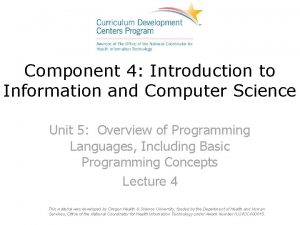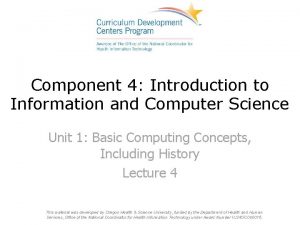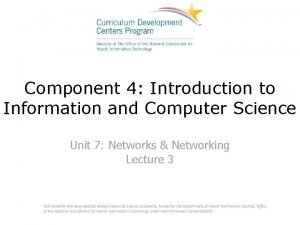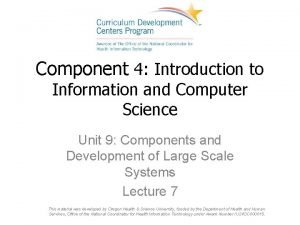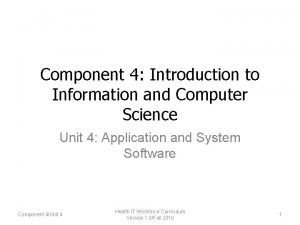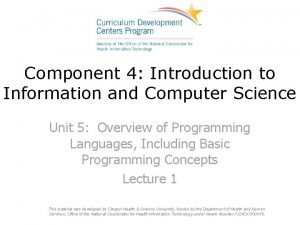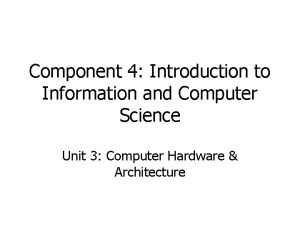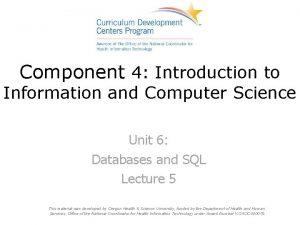Component 4 Introduction to Information and Computer Science

























- Slides: 25

Component 4: Introduction to Information and Computer Science Unit 7: Networks & Networking (Part 3 of 5)

Unit Objectives • Understand the history of networks and their evolution. • List and describe the various types of network communications. • List and describe the various forms of network addressing, including DNS. • List and define the different types of networks. • Describe different network topologies. • List and describe different network standards and protocols. • Describe wireless communication. • List and describe network hardware. • Explain networking logical model concepts. Component 4/Unit 7 c Health IT Workforce Curriculum Version 1. 0/Fall 2010 2

Network Types • Wired or wireless network types. • Wired network governed by IEEE 802. 3 standard. • Wireless network governed by IEEE 802. 11 standard. • Easy to remember which standard governs which technology: • Take the “ 3” in 802. 3 and flip it around so it looks like an “E”. 802. 3 sets the standard for Ethernet, which usually applies to wired networks. • Take the “ 11” in 802. 11 and hold up two fingers to emulate the antennae on a WAP or wireless NIC. Component 4/Unit 7 c Health IT Workforce Curriculum Version 1. 0/Fall 2010 3

Local Area Networks - LANs • Network with small geographical area of coverage. • Term “small” is arbitrary! • Usually one company with one site. • Wireless LAN called a WLAN. • LAN examples: ü ü Home Office Building Small school with three buildings Component 4/Unit 7 c Health IT Workforce Curriculum Version 1. 0/Fall 2010 4

LAN Management - Workgroups • Workgroup based: • By default, uses network name of “WORKGROUP” on all LAN devices. • Referred to as a peer-to-peer network since no server exists to manage the LAN. Component 4/Unit 7 c Health IT Workforce Curriculum Version 1. 0/Fall 2010 5

LAN Management – Server Domains • Server Domain based: • Uses network name designated by network administrators. • Requires a server to manage the domain, which is a LAN under common administration. – Domain is similar to a gated community. • Only community members can use domain resources. – Community members are users and devices added to domain by network administration. • Server acts as gatekeeper and keeps database of users and devices. – Also enforces domain rules and much more! Component 4/Unit 7 c Health IT Workforce Curriculum Version 1. 0/Fall 2010 6

Wide Area Networks - WANs • Network with large geographical area of coverage. • Term “large” is arbitrary! • WAN usually made up of > 1 LAN. • Same company, multiple sites. . • May or may not have Internet access. • WAN examples: • Offices in Chicago and London need to share servers. • Five Portland offices (same city) need to share files. • Intel, Dell, and Microsoft need to collaborate on the creation of a new product. – WAN facilitates inter-company communications. Component 4/Unit 7 c Health IT Workforce Curriculum Version 1. 0/Fall 2010 7

Metropolitan Area Networks - MANs • Network with large area of coverage, but same city. • Term “large” is arbitrary! • MAN usually made up of > 1 LAN. • Same company, multiple physical sites. • Office connected by fiber-optic links or other highspeed media. • May or may not have Internet access. • MAN examples: • Company has many offices in same city. • Large college campus. Component 4/Unit 7 c Health IT Workforce Curriculum Version 1. 0/Fall 2010 8

Network Topologies • Topology refers to network layout. • Two types of network topologies exist. • Physical topology details how the network is physically designed. • Logical topology diagrams illustrate how data flows through the network regardless of physical design. • Some topologies represent both logical and physical networks using the same name. Component 4/Unit 7 c Health IT Workforce Curriculum Version 1. 0/Fall 2010 9

Physical Topologies • Many physical topologies exist! • Main types are: Component 4/Unit 7 c Health IT Workforce Curriculum Version 1. 0/Fall 2010 10

Physical Topologies - Bus • Each host is connected to every other host via a single network cable with connectors. • If cable breaks, whole network goes down! • Not in use since late 1990 s. Component 4/Unit 7 c Health IT Workforce Curriculum Version 1. 0/Fall 2010 11

Physical Topologies - Mesh • Each host is connected to every other host, usually by a switch or direct connection. • Some networks are partial – not full – mesh topologies. Component 4/Unit 7 c Health IT Workforce Curriculum Version 1. 0/Fall 2010 12

Physical Topologies - Ring • Each host is connected to the network in a closed loop or ring. • Uncommon network type found in highly secure environments. • Ring topologies typically utilize a token passing scheme, used to control access to the network. • By utilizing this scheme, only one machine can transmit on the network at a time. Component 4/Unit 7 c Health IT Workforce Curriculum Version 1. 0/Fall 2010 13

Physical Topologies - Star • Each network host is connected to a central switch. • Most common topology type. • Easiest topology type to set up and maintain. • All traffic passes through the switch. Component 4/Unit 7 c Health IT Workforce Curriculum Version 1. 0/Fall 2010 14

Logical Topologies • The logical topology, in contrast to the "physical", is the way that the data passes through the network from one device to the next without regard to the physical interconnection of the devices. • A network's logical topology is not necessarily the same as its physical topology. • For example, twisted pair Ethernet is a logical bus topology in a physical star topology layout. Component 4/Unit 7 c Health IT Workforce Curriculum Version 1. 0/Fall 2010 15

Network Standards and Protocols • The Institute of Electrical and Electronics Engineers or IEEE creates and publishes networking and many other standards. • Standards mean that products from various vendors will work together. • Protocols govern communications. • Example: You install an Intel NIC on your computer and your friend installs a 3 Com NIC on his computer. Both computers can communicate flawlessly because both NICs adhere to IEEE standards for network communication. Component 4/Unit 7 c Health IT Workforce Curriculum Version 1. 0/Fall 2010 16

Standardized Communications • Internet Protocols are a global standard, ensuring interoperability between hardware and software devices. ü Internet Protocol (IP) addressing is required for home and office networks to function properly. ü IP addressing allows any device with Internet access to communicate with another device on the Internet. ü TCP/IP transports HTTP across the Internet for delivery to its destination. ü Protocols such as HTTP allow any browser to talk to any Web server. Component 4/Unit 7 c Health IT Workforce Curriculum Version 1. 0/Fall 2010 17

Network Standards • • Ethernet Token ring Wi-Fi Wi. MAX WAP (Wireless Application Protocol) RFID (Radio frequency Identification) Bluetooth Component 4/Unit 7 c Health IT Workforce Curriculum Version 1. 0/Fall 2010 18

Ethernet Network Standard • • • Concepts developed 1973 -1975. IEEE Standard 802. 3. Defines standards for wiring and signaling. Standard defines frame formats, etc. Widely used today. Component 4/Unit 7 c Health IT Workforce Curriculum Version 1. 0/Fall 2010 19

Token Ring Network Standard • Concepts developed in 1985. • IEEE 802. 5 standard. • Named after its logical topology. • Physical topology is a star. Ø Devices connect to each other via a switch. • Communicating devices need to possess the digital token that is passed around the ring. Ø Devices pass the token until they need to communicate – then hold it until finished. • Put of business by Ethernet. Ø Ethernet much faster and easier to implement. Component 4/Unit 7 c Health IT Workforce Curriculum Version 1. 0/Fall 2010 20

Wi-Fi Network Standard • Concepts evolved 1997 – today. • IEEE 802. 11 standard for wireless LANs • Family of wireless protocols • 802. 11 A/B/G/Draft N • Standard defines throughput, frame formats, etc. • Uses frequencies (channels) for wireless communication. • 802. 11 A uses 5. 0 GHz wireless band. • 802. 11 B/G uses 2. 4 GHz wireless band. • 802. 11 N uses both bands. Component 4/Unit 7 c Health IT Workforce Curriculum Version 1. 0/Fall 2010 21

Wi. MAX Network Standard • Concept developed ca. 2004. • IEEE 802. 16 standard for WAN wireless. • Telecommunications protocol that provides fixed and fully mobile internet access. • Example: Ø Wi. MAX access was used to assist with communications in Aceh, Indonesia, after the tsunami in December 2004. Wi. MAX provided broadband access that helped regenerate communication to and from Aceh. Component 4/Unit 7 c Health IT Workforce Curriculum Version 1. 0/Fall 2010 22

Wireless Application Protocol (WAP) • Open international standard for application-layer network communications in a wirelesscommunication environment. • Standard describes a protocol suite allowing the interoperability of WAP equipment and software with many different network technologies. • Concept developed ca. 1997. • Most use of WAP involves accessing the mobile web from a mobile phone or from a PDA. Component 4/Unit 7 c Health IT Workforce Curriculum Version 1. 0/Fall 2010 23

Radio-Frequency Identification (RFID) • Use of an RFID tag incorporated into an object using radio waves. • Most RFID tags contain at least two parts: Ø Integrated circuit stores information. Ø Antenna for sending/receiving signals. • Many organizations govern standard • International Organization for Standardization (ISO) • International Electrotechnical Commission (IEC) • Others Component 4/Unit 7 c Health IT Workforce Curriculum Version 1. 0/Fall 2010 24

Bluetooth • Concept developed ca. 1994 to present. • IEEE 802. 15 standard. • Open wireless technology standard for exchanging data over short distances from fixed and mobile devices. • Used by medical implants, keyboard, mouse. A Bluetooth USB dongle. Component 4/Unit 7 c Health IT Workforce Curriculum Version 1. 0/Fall 2010 25
 Anticipating misuse computer science
Anticipating misuse computer science Science fusion online
Science fusion online My favorite subject is science
My favorite subject is science Introduction to computer science midterm exam
Introduction to computer science midterm exam Introduction to computer science midterm exam test
Introduction to computer science midterm exam test Introduction to computer science quiz
Introduction to computer science quiz Python programming an introduction to computer science
Python programming an introduction to computer science Software components example
Software components example Output devices definition
Output devices definition Enable nui in process gpu
Enable nui in process gpu The component of interactive computer graphics are
The component of interactive computer graphics are Lincoln pizza ordering system dfd answer
Lincoln pizza ordering system dfd answer Anthropology vs sociology
Anthropology vs sociology Hard science and soft science
Hard science and soft science Health and social care component 3 health and wellbeing
Health and social care component 3 health and wellbeing Computer science input and output
Computer science input and output Difference between ba and bs in computer science
Difference between ba and bs in computer science Ucf college of engineering and computer science
Ucf college of engineering and computer science Erik jonsson school of engineering and computer science
Erik jonsson school of engineering and computer science Computer science and engineering unr
Computer science and engineering unr Eecs ucla
Eecs ucla -h#ps://microbit.org/fr/
-h#ps://microbit.org/fr/ Erik jonsson school of engineering and computer science
Erik jonsson school of engineering and computer science Erik jonsson school of engineering and computer science
Erik jonsson school of engineering and computer science Swot analysis in library and information science
Swot analysis in library and information science General objectives of computer
General objectives of computer
